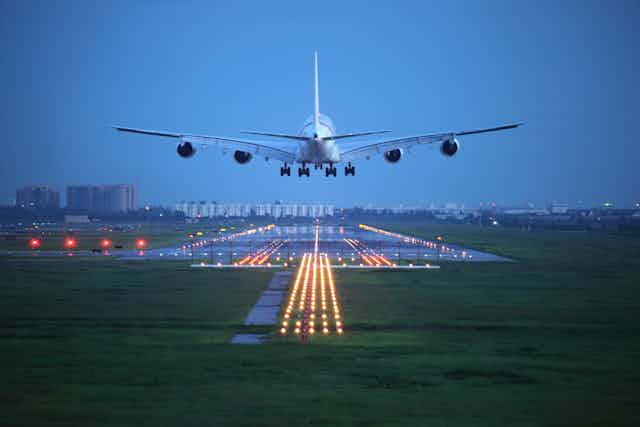London’s Heathrow airport is currently operating at 98% capacity – and the rest of London’s airports are set to be full by 2040. The debate over how to address this problem has been raging for years – but a workable solution has yet to be found.
Several strategies have been considered to help free up more space for air traffic – there have been proposals for an extra runway at Heathrow, Gatwick or Stansted, or even a brand new airport in the Thames Estuary. Following an independent report by the Airports Commission in July 2015, Heathrow was recommended as the best candidate for expansion, with a new northwest runway to cater for an extra 35m passengers per annum.
But still the argument rages on. The Heathrow proposal has been met with vocal opposition from environmental groups, key political figures and residents who would be affected by the changes. Meanwhile, business groups including the Institute of Directors, the CBI and the British Chambers of Commerce have pledged support for the Heathrow expansion, as a way of protecting and promoting the UK’s economic interests.
Now, the UK government has deferred its decision on how best to increase London’s airport capacity until the summer of 2016, by commissioning a further study on the new runway’s environmental impacts.
Underlying all these discussions is the assumption that something must be done to increase London’s airport capacity. This is based on a traditional approach to transport planning, called “predict and provide” – wherein authorities try to estimate and cater for future transport requirements. But what if that isn’t our only option?
Indeed, when it comes to road travel, “predict and provide” has been largely abandoned by developed economies. These days the favoured approach is called “managing demand”. This method works on the basis that attempting to meet an ever-growing demand is impractical: instead, systems can be managed to encourage people to take more sustainable modes of transport.

For example, in the 1970s London’s authorities opted not to enlarge the road network to accommodate growing car ownership. Since then, London’s historic street pattern, as well as disincentives such as the congestion charge, have constrained car use. Car traffic has not increased over the past 20 years, despite a period of population and income growth. So the share of journeys by car has fallen, while investment in public transport – rail in particular – has met the mobility needs of inhabitants and visitors. London has thrived economically, culturally and socially despite the major capacity constraints of its road system.
Constraining capacity
So what would happen if we didn’t build another runway at all? For air travel, the answer lies within the market. Three–quarters of passengers are on leisure trips – and, even at Heathrow, 70% of passengers are tourists, or visiting family and friends. Yet the arguments for more runway capacity are largely about the need to allow for the growth of business travel: to help British business develop new markets overseas, to foster inward investment into the UK and to allow London to continue to develop as a world city.
The case for more airport capacity to support inbound tourism is weak. While London’s hospitality, entertainment and retail sectors would welcome more visitors, Britain has a negative balance of trade in tourism: that is, British people abroad spend a lot more each year than overseas visitors to the UK. And, while London is the typical destination for first-time visitors to Britain, the capital is essentially a working city – you could argue that excessive numbers of tourists detract from the quality of life. So the promotion of inbound tourism might better focus on places outside the capital, which are accessible from regional airports.

If we decided not to build a further runway at Heathrow, the market would respond to this capacity constraint by accommodating the most valuable passengers through price increases. Business travellers would command priority, since they would be willing to pay for the convenience, connections and direct flights at Heathrow. The growth of business travel would displace leisure travel, both within aircraft on existing routes and between routes, where time is traded against money.
For instance, when I travel to India on a business trip for which others are paying, then if possible I would fly direct from Heathrow. But if I am on a holiday visit, paying out of my own pocket, than I may choose the cheaper alternative via a Middle East hub – the inconvenience of the change of aircraft would be acceptable because of the more attractive price on offer.
At present, both routes to India start from Heathrow. As passenger numbers grow, the airlines would serve the routes with larger aircraft. If demand grew yet further, then alternative departure points for leisure travellers would be offered at subsidiary airports such as Stansted, which has the capacity to more than double its passenger throughput from 20m to 40-45m passengers per year without expansion.
The growth of business travel under the conditions of capacity constraint would be profitable for both the airlines and Heathrow airport. If profits were judged excessive, then regulatory interventions such as a cap on charges could be considered to prevent travellers from being exploited.
There is a case for an additional runway in south-east England, as argued by the Airports Commission. But if it proves too difficult to agree where to build it, then we could manage without. The market would give priority to business travellers, while the more flexible leisure travellers would take advantage of the cheaper, alternative routes offered by competing airlines. Managing the demand for air travel though market mechanisms is a viable alternative to building more airport capacity – especially where environmental concerns generate strong political opposition.

